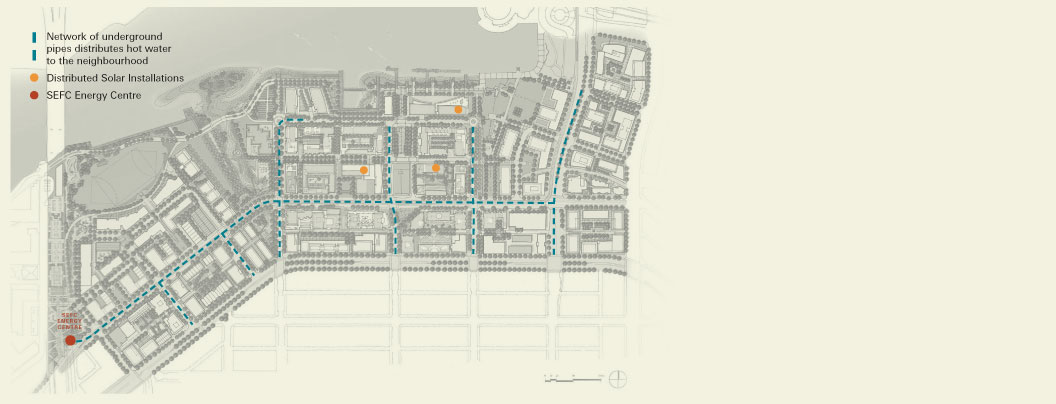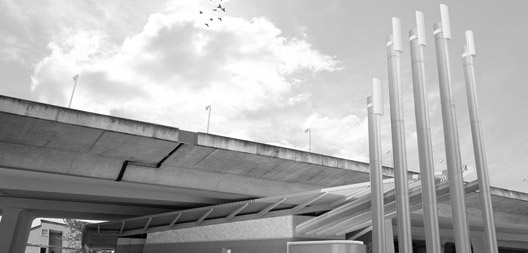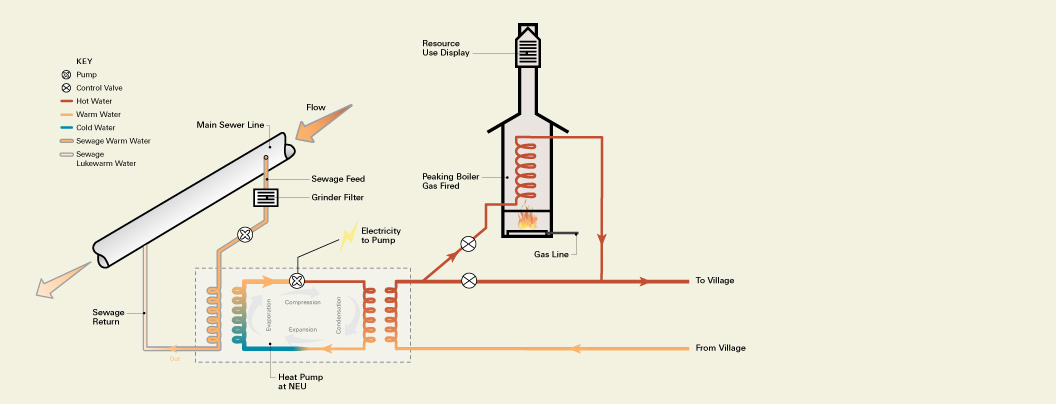Community Energy
District Heating: Why do It?
District energy systems distribute heat generated in a centralized location for residential and commercial hot water and space heating requirements. Heat energy from a district energy system is distributed through underground insulated pipes that connect to buildings. District energy systems eliminate the need for a boiler or furnace in each individual building and can provide higher efficiencies and better pollution control than localized equipment. Beyond fossil fuels traditionally used for heat production, district energy systems are adaptable to a wide variety of alternative energy sources including geo-exchange, solar, biomass, waste heat recovery and nuclear power.
“District energy was the vehicle for meeting our renewable energy supply objectives”
Chris Baber, NEU Manager, City of Vancouver
Among the guidelines that governed the redevelopment of SEFC were ambitious greenhouse gas reduction and energy-efficiency objectives. In 2003, Brian Crowe, the City of Vancouver’s Assistant City Engineer for Water and Sewers, championed the idea of implementing a district energy system as a means of meeting energy efficiency and sustainability targets. District energy systems offer the flexibility of using a wide range of renewable energy resources. For this reason, the City of Vancouver’s Neighbourhood Energy Utility (NEU) team had their choice of technologies.
“First we had to determine our objectives,” says Chris Baber, the City of Vancouver’s NEU Manager, “by identifying the types of energy usage and quantifying the demand.” Designing an efficient district energy system requires a holistic approach to system design. To choose an appropriate energy source, the team had to determine which technology would best meet the social, environmental and economic objectives and constraints of the new community.
To help with this, FVB Energy and Compass Resource Management were retained by the City of Vancouver to conduct a district energy feasibility analysis. FVB Energy analyzed a wide variety of energy source options, producing a “Heat Source Options” report for the City. Two viable alternatives emerged from this process: biomass or sewer heat recovery. Compass Resource Management, led by Trent Barry, produced a business analysis report evaluating the economic, environmental and social performance of the two heat source options. Based on the results of this study, the City of Vancouver approved the development of the NEU in spring 2006. The NEU team explored the two options in depth, hosting a series of public consultations before eventually arriving at a decision.
The Contenders: Biomass vs. Sewer Heat Recovery
Biomass
A biomass facility is a boiler-based energy plant that efficiently burns wood or other organic waste. Modern biomass plants are equipped with state-of-the-art emissions controls to mitigate adverse effects on air quality. As an energy source, biomass is considered to be greenhouse gas neutral since wood waste emits carbon dioxide into the atmosphere regardless of whether it is burned or left to decompose naturally. Biomass has gained popularity in northern Europe due to its low environmental impact. There are a few examples of biomass plants locally, in Seattle, Washington, and Revelstoke, BC.
Sewer Heat Recovery
Sewer heat recovery, in contrast, is a less proven technology than biomass. There are only three sewer heat recovery systems worldwide that recover heat from untreated sewage, two in Oslo, Norway and one in Tokyo, Japan. Sewer heat recovery captures waste heat from municipal sewage. Similar to a geo-exchange system, electric heat pumps transfer thermal energy from warm sewage (12–25 degrees Celsius) to a higher temperature useful for residential space heating and domestic hot water. Compared to geoexchange, sewer heat recovery is more efficient due to higher heat source temperature and lower installation costs.
“Nobody’s ever captured heat from mid-system in the middle of the city.”
Ray Tarnai, Sandwell
Public Consultation
The City of Vancouver initiated a public consultation process to determine which technology would be implemented. As both biomass and sewer heat recovery were relatively foreign concepts, the public responded with both a keen level of interest and a high level of concern.
For the biomass option, there was a widely held perception that the combustion process would result in harmful air pollution, that the neighbourhood would be negatively impacted by fuel deliveries, and that it would require an unsightly industrial smokestack. The public was more supportive of sewer heat recovery, though concerns were raised about the possibility of odour and contamination.
“Implementing a new technology requires a great deal of public education,” says Chris Baber. “The public’s perceptions are not always based on technological facts. If you don’t have sufficient materials to present when you go public, people’s imaginations are left to fill the gaps. If we had had (an additional) six or twelve months, we would have continued to work with the public to address the perception issues.” In the case of this project, in order to stay on schedule the NEU team had to decide which system to implement. Sewer heat recovery prevailed as the technology of choice.
The City initiated a second public engagement process concerning the design of the False Creek Community Energy Centre, the facility that would house the NEU operations (see page 12). At the outset, the public was apprehensive about the construction of an industrial facility amidst a highdensity residential neighbourhood. “People were fearful of opening up the sewer in their neighbourhood…but it became educational,” says Ray Tarnai of Sandwell, the engineering consultants who held the contract for the design of the Energy Centre. Despite the fears that were raised, “We thought, we’ve got to do something, we can’t do nothing. We needed to find the right solution for the future,” remembers Tarnai. “In the end, the public said, ‘we’re okay, as long as we don’t notice it.’”
Sewer Heat Recovery
SEFC Taps into a Local, Renewable Heat Source
The SEFC NEU is a community energy system designed to use and distribute heat energy from a variety of renewable sources. In the first phase of development it will get the bulk of its energy from heat recovery from an existing municipal sewer line adjacent to the SEFC site. This means that heat is captured and used in close proximity to its source, rather than transferring it from an off-site sewage treatment plant, reducing the cost and inefficiencies of transmission over a distance. The NEU’s localized sewer heat recovery system is the first application of this technology in North America and is ideal in a dense urban environment. “This type of sewage heat recovery system should be replicable and transferable to future urban district energy projects that will be developed in other areas,” says Baber.
How it Works
You cook a pot of pasta – and drain the boiling water down the sink. Water from hot showers, clothes washers and dishwashers join it – “waste” heat that represents a significant amount of available energy. But how does the warmth captured from the sewer become usable energy to heat a condominium at SEFC?
The answer lies in a heat exchange process integrated with a new municipal sewage pump station. Similar to a geo-exchange (or geothermal) system, heat pumps transfer thermal energy from the warm sewage supply to a higher temperature range that’s effective for residential space heating and domestic hot water. While similar in concept, sewage heat recovery is more efficient and cost effective than typical geo-exchange systems. The heat source (raw sewage) has a higher temperature than ground-source heat (on average 18 degrees Celsius as opposed to 8), so it requires less energy to upgrade. Secondly, accessing the sewer line is less invasive and less capital cost intensive than drilling into the earth to access geothermal heat. It also utilizes a continuous supply of waste heat, closing the loop on a fundamental energy >> waste >> energy stream. According to the City of Vancouver, the sewage heat recovery will supply approximately 70% of the neighbourhood’s annual heating and hot water energy demand, and will produce 50% less greenhouse gas emissions compared to conventional energy sources.


A distribution pipe system runs beneath the streets at SEFC, delivering thermal energy in the form of heated water from the Energy Centre to each of the buildings. Pipes are well insulated in order to reduce or eliminate energy loss through the distribution process.
Heat Distribution at a Glance
Efficiency and Adaptability
All buildings at the Olympic Village are connected to the NEU by a system of underground piping that distributes the thermal energy. There are three main components to the NEU: the NEU Energy Centre, distribution pipe system and energy transfer stations. The following is an overview of the energy transfer process:
1. The sewage heat recovery process is co-located with a sewage pump station at the False Creek Community Energy Centre, under the south end of the Cambie Street Bridge. On cold days when the heat demand is the highest, the system will be augmented by heat produced by three high-efficiency natural gas boilers. Using natural gas for backup and peak demands ensures reliability and competitive costs.
2. Distribution pipes circulate hot water from the energy centre to buildings and return slightly cooler water back to the energy centre. The pipes are well insulated to minimize energy loss during the distribution process.
3. Energy Transfer Stations located within each SEFC building produce space heat and domestic hot water to be distributed to occupants by the customer building’s mechanical system. Metering will be incorporated in the Energy Transfer Stations for energy measurement and billing purposes.


This distribution diagram shows the central piping network that connects each building to the NEU and locates the three solar array systems on site.
Future-proofing
The NEU is designed to service all 32 hectares of SEFC: an estimated 16,000 people, plus commercial and institutional facilities. The NEU was built in such a way that it can be expanded to meet growing demand. At the moment, its primary energy source is sewer heat recovery. The system will also accept heat energy from a variety of waste heat and renewable energy sources, and was designed on the basis that new energy supply would be added as the system expands in the future. This flexibility enables the system to keep pace with technology advancements, future-proofing customer buildings and ensuring long-term energy security and affordability. “This project
could become a real benchmark system in North America,” says Tarnai.
Incorporating Renewable Technologies
Integrated Renewable Energy: Thermal Net Metering
Three of the buildings at the Olympic Village feature roof-mounted solar thermal arrays. This technology captures the energy from the sun for domestic hot water heating. During peak sunlight periods, the solar systems will generate a surplus of heat energy – in excess of the building’s demand for hot water. Rather than waste this free, renewable energy, excess heat from the solar arrays is sold to the NEU through energy transfer stations. The energy is then redistributed through the NEU pipes for use in other buildings. The energy transfer is regulated through a ‘thermal net metering’ provision in the City’s Energy Utility System Bylaw, whereby the NEU purchases excess energy from the individual customer. This two-way energy transfer system design enables any micro-producer of thermal energy that is connected to the system to sell their excess energy to the utility.


Photos of the solar array structure being installed on the roof of the net zero building on parcel 9.
Long-Term Outlook
District energy systems are not new. Vancouver has a number of legacy steam heat systems that serve the downtown core, and three of the city’s large hospital sites. The City of Vancouver is exploring future opportunities to introduce the district energy model, with staff mapping potential future sites and identifying sources of waste heat as part of a city-wide district energy study. Areas that are being developed to support a dense population are prime candidates for an infrastructure and utility program similar to the NEU. In addition, the City is exploring the opportunity of switching the local legacy steam heat systems from fossil fuels to renewable energy sources.


Photos of the solar array structure being installed on the roof of the net zero building on parcel 9.
False Creek Community Energy Centre
The False Creek Community Energy Centre building is designed as an interpretive facility to showcase the innovative use of sustainable technology. The building, designed by Walter Francl Architecture, is targeting LEED™ Platinum Gold certification. “There is an emphasis on information and public education, and a high degree of transparency to the building,” says Francl, alluding to the street level portals that allow the public to view the machinery down below. The City of Vancouver had a strong interest in showcasing this innovative technology, so it initiated a public dialogue about how the building would be designed, including design charrettes with local residents and two well-attended open houses. Francl comments that “though the building is, in essence, an infrastructure project, we didn’t want to contain it completely in a windowless box. We were challenged with designing an attractive building form for a sewage pump station.” The designs were well received. At the City’s open houses, recalls Baber, “the public expressed overwhelming support for the technology and design.”
One of the challenges of designing the building was keeping its footprint as small as possible in an effort to preserve public right-of-ways in the vicinity of SEFC. “The building responds to existing urban design form,” says Francl. “Three-quarters of what’s happening in this building takes place underground.” The Energy Centre is located directly underneath the Cambie Street Bridge, a car, bike and pedestrian bridge that leads to Vancouver’s central business district. Given the close proximity of the bridge footings, specialized excavation methods had to be used to ensure that the structural integrity of the bridge was not compromised. The building’s small footprint freed up half of the site for landscaping, and its above-ground portion is designed to accommodate tours and serve as a public education resource.
Public Art
Artistic Interpretation Adds Visual Appeal to the NEU
“It’s a great example of how good design and a good public process can bring people on board”
Chris Baber, NEU Manager, City of Vancouver
In an effort to make the new building aesthetically appealing and to draw attention to the sustainability and innovation of the NEU, the project commissioned local artists to provide a design that would transform the system’s emissions stacks to a community amenity. Local designers Pechet and Robb Art and Architecture were up to the challenge, coming up with a design both attractive and functional.


Above, the artists’ rendering and schematic drawing of the Energy Centre’s sculpted stainless steel hand. The fingernails are LED lighting fixtures that will change colour to reflect the amount of green energy being produced by the system.
The NEU has five exhaust flues: three for the three natural gas boilers, one for an odour control system and one linked to an emergency generator. Pechet and Robb’s approach was to instill a “human quality” to these flues, their rationale being, “it seemed significant that the [Energy Centre] will be heating people with existing body heat,” says designer Stephanie Robb. The stacks extend into a sculpted stainless steel “hand,” with each 22-metre long “finger” (flue) topped by an inclined “fingernail”. The fingernails are LED lighting fixtures that will change colour to reflect the amount of green energy being produced by the system.
This artistic interpretation adds visual appeal to the NEU, inspiring residents and passersby to take an interest in the neighbourhood’s sustainable infrastructure. “Initially, at the public consultations, people raised concerns about the appearance of the stacks,” says Baber, “Today that’s the part that people are most excited about. It’s a great example of how good design and a good public process can bring people on board.”





